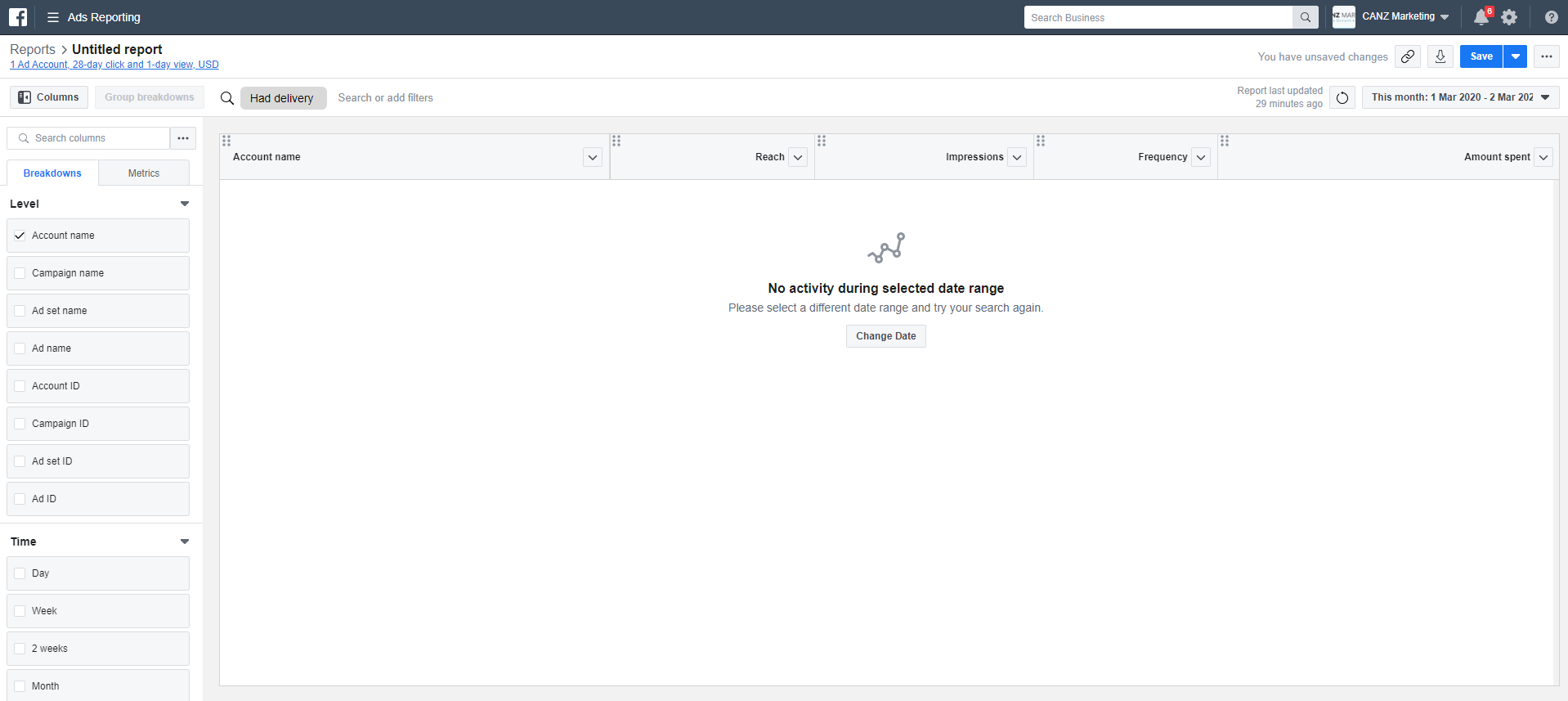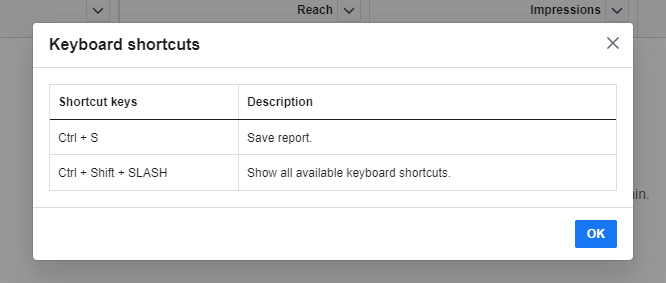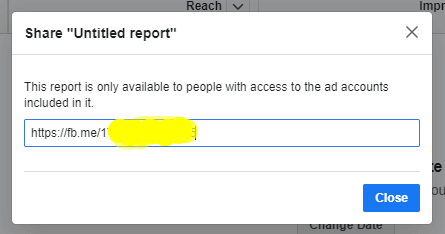Facebook Business Manager – Ads Reporting: A Complete Guide

Facebook Ads Manager, or Facebook advertising; even Business Manager Ads Reporting!
Why care?
Because you get positive results, only choosing the right platform (and Facebook is the right advertising platform for most businesses). No matter how great a marketer you become, you are always in need to test and learn. And to test and learn the right way, you need to monitor.
Monitor what?
Monitor all your Ads; all their progress. Monitor all of whatever is going on, on the page, and in the ads manager.
But again, why does it all matter?
Because proper monitoring gives you a complete and clear picture, only with a clear image, can you have better control of the results with an advertising strategy for strategic optimization.
Today’s blog is all about Facebook Ads Manager and the Reporting features in Business Manager. Facebook Business Manager Settings
If you are a learner wondering what these two important sections deal with, stay with us. Because by the end of the post, you would already have mastered the Facebook Ads Manager and the Reporting tool in Facebook Business Manager.
Facebook Business Manager allows you to reach roughly the same amount of data and features in several ways.
- Ads Reporting
- What Is The Ads-Reporting Feature in Facebook Business Manager? What Does It Do?
- Where is Ads Reporting Tool In The Business Manager?
- Digging into Ads Reporting Window
- Facebook Ads Manager
- What can you do in Facebook Ads Manager?
- What are the core components of the Facebook Ads Manager?
- All done. What next?
Let us get started with the Reporting feature in the business manager first:
Ads Reporting
What Is The Ads-Reporting Feature in Facebook Business Manager? What Does It Do?
Reporting is an essential part of the process of optimization. A Facebook ads strategy for future ads is considered on point when it is based on the results of previous reports.
The Facebook business manager Ads reporting tool allows you to:
- Create auto and manual reports
- Customize your reports based on your goals, parameters and based on how deep you want to dig
- Schedule reports
- Export reporting data
- Share with one to multiple recipients
In short, the business manager’s ad reporting section allows advertising analysis as well as reporting and sharing.
Where is Ads Reporting Tool In The Business Manager?
If it’s your first time you are into Facebook ads reporting, here’s how you get to the reporting tool:
- Sign in to your Business Manager Account (Assuming you have one; if not, here’s how our guide to creating one.)
- Head to the *Business Manager* tab on the top left, right next to the Facebook sign.
- Click to view five columns and the variety of functions each one performs.
- Head to the third column. Your destination is the first option.
- Click *Ads reporting*. As you set your feet in the reporting area for the first time, this is what your window would look like:
Let’s dig deeper into the Reporting tool and see what is it capable of:
Digging into Ads Reporting Window
Let us look into each of the options on the (last) screen. We’d see what each of these means, and how to read data using each.
If you look closely into the (same, last) screen, here’s how you can fix your report (starting from the left side):
Name
Say you are running ads for a client, and your ads are showing results.
What do you want to do next?
It is that time around when you want to load them up and send them to the client.
First thing first, give your report an identifiable name (so you can easily pick it up even from a pool of reports).
Until you name it, it remains *untitled*.
Filter
Under the naming section, you’d see columns (calling for collapsing the side pane) and group breakdowns, as well as the filter option.
You can select an appropriate option to pick and apply the filter and find the appropriate information.
- Ad Account
- Name/ID
- Add account name
- Campaign name
- Ad set name
- Ad name
- Campaign ID
- Ad set ID
- Objective
Columns
While you can search for columns with a search option under the *Columns* button, the dots offer three other options:
- Arrange columns (where all the breakdowns and metrics are set by default so far and are removable.)
- Breakdowns
- Account name
- Breakdowns
- Compare attribution windows
- Metrics
- Reach
- Impressions
- Frequency
- Amount Spent
- Metrics
- Remove all columns
Breakdowns
At the breakdowns, you can pick the level you need the information for. The offered options are:
- Account Name
- Campaign name
- Ad set name
- Ad name
- Account ID
- Campaign ID
- Ad set ID
- Ad ID
You can pick the period you need the report for:
- Day
- Week
- Two weeks
- Month
Facebook can break down your ad results into the following delivery options:
- Age
- Gender
- Country
- Region
- Impression device
- Platform
- Placement
- Device platform
- Time of the day
You can choose as many reporting delivery options as deeper you want to dig into the analytics.
Under the *Action* button, you can pick *conversion device* to see the best device option for your ads.
Metrics
To manage what you see in the report, you can switch to metrics from the breakdown. Facebook offers you several metrics to measure each of the following goals:
- Performance
- Engagement
- Conversions
- Custom Conversions (Read Jon Loomer’s guide on what on earth is that)
- Settings
You can also create custom metrics to measure your own goals.
Keyboard Shortcuts
You’d notice three dots on the extreme right top. Click on the dots, and you’d see *Keyboard Shortcuts*. Click.
On the pop-up menu, you’d view all the shortcuts. We just gave you the shortcut to download your report (in the future).
Save
Next to the dots, you’d see the *Save* button. Clicking it enables you to save your report at the desired destination in your system with the desired name (referring to *Save as*).
Export
Next to that, you’d see the download symbol, saying *Export*. Click on export to see the allowed versions of the exportable report. Choose your desired format and hit *Export*.
The desired format report would be downloaded with a title you chose for it (or untitled), followed by the download date. Open and view your data.
Next to the export symbol is the linking symbol, saying *Share Link*. Click on that to view the shareable link. Anyone with the link would have access to the report in the business manager.
Reporting Date
Right under the options mentioned above is the date. The date option in the reporting section works the same as it does in Ads Manager.
In case you are wondering, all the options are useful when you have the ads running and have some data to be classified.
Once you have some data to share in a report, all the points would seem to fall in place.
Example
If you were running the ads (say, lead generation ads), your ads report would look something like this:
This is not a sample report, and the metrics shown in the report are the ones we picked ourselves.
That’s all about the reporting section.
But that’s not all about reporting.
There is one more way to access the same information for creating and viewing reports:
Facebook Ads Manager
What can you do in Facebook Ads Manager?
There are three core functions you can perform within the Facebook Ads Manager:
- Creating Ads
- View Stats
- Create Reports
And these are the most important tasks that you have to perform in advertising.
What are the core components of the Facebook Ads Manager?
The core components are all built around the core functions of the Ads manager i.e., ads creation and ads reporting:
Search
The search bar at the top left is where you can search any campaign, adset, or ad.
Say you want to search a campaign with its name, your filter would go to the Campaign name. Type the part of the campaign name in *contains* bar, and hit enter. Your results would be displayed right below.
Filter
There are countless filter options to pick from to view your stats. Here are your options:
- Campaign delivery
- Active
- Deleted
- Inactive
- Off
- Pending
- Ad set delivery (options are the same as for campaign delivery)
- Ad delivery (options are the same as for the above two options)
- Objectives
- App installs
- Brand awareness
- Catalog sales
- Conversions
- Desktop App Engagement
- Desktop App Installs
- Event responses
- Lead generation
- Messages
- Mobile App engagement
- Mobile App Installs
- Offer claims
- Page likes
- Page engagement
- Reach
- Store traffic
- Traffic
- Video Views
- Placements
- Facebook feeds (desktop)
- Instagram feed
- Facebook feeds (mobile)
- Instagram stories
- Facebook right column
- Audience network
- Facebook marketplace
- Messenger inbox
- Messenger stories
- Facebook in-stream video (desktop)
- Facebook in-stream video (mobile)
- Campaign Metrics
- Cost per result
- CPA
- CPM
- Frequency
- Impressions
- Lifetime spent
- Reach
- Ad set metrics (the options are the same as for campaign metrics)
- Ad metrics (options are the same as for campaign and ad set metrics)
- Audience Age
- 13-17
- 18-24
- 25-34
- 35-44
- 45-54
- 55-64
- >64
- Audience delivery changes
- Will be affected
- Currently affected
- Not delivering
- Audience gender
- Male
- Female
- Uncategorized
- Audience location
- Location (write the location in the search bar next to the filter option)
- Recent Campaign changes
- Recently changed
- Recent Ad set changes
- Recent Ad changes
- Split Test
You can also save some filters to view them under *Saved Filters*.
Date
Facebook gives you the following time presets as the reporting period:
- Today
- Yesterday
- Last 7 days
- This week
- Last week
- This month
- Last 14 days
- Lifetime
- Last month
- And last 30 days
Except for *today*, no other options include *today’s report*.
If you don’t want to pick from the presets, you could randomly choose any date. Alternatively, select 2 dates to view the reports for the period between them.
Account Overview
Account overview, as the name implies, gives you a glance at what’s going on in the account. The overview gives you the idea if your efforts are fruitful or not.
If you have some running campaigns that are fetching results, this is basically an overview of what your results are and where they are coming from.
So this is basically everything else summed up.
Campaigns
The campaign is the main and the most significant unit of your advertisement. Each campaign has the lower unit – ad sets – ranging from one to many per campaign.
Here you’d be able to view the campaign-level results. When you click on *Campaign*, you’d see all the running ad sets in your selected campaign.
Ad sets
Clicking on the adset lands you on all the assets of your adset. If you check a campaign and then go to adset, you’d be able to view the adset level results of that particular campaign. Read more: Facebook Business Manager Assets
Ads
An ad is the lowest unit in a campaign (under ad set), but the main one that you are interested in because this is what your target audience can see.
Under each ad set, you can have one to many ads. At this level, you can view the ad-level results of the ad set.
Create
*Create* section is the primary purpose you get to see the Ads manager. Here is where you create your ads and run all the campaigns.
Introducing briefly, *Cerate* section creates all the masterpieces (campaigns, ad sets, and ads) that bring your business to life and convert the potentials.
The details are, however, the scope of another post.
For now, we’d focus on the reporting aspects of Business and Ads Manager.
If you paid attention to whatever we walked you through, you’d be able to tell we were actually revolving more around reporting and learning the stats (except for the *creation* section).
Let’s keep digging deeper.
Columns
The dropdown menu *Columns* is one of the four important functional units of the Ads Manager. The other three are:
- Breakdown
- Reports
- Create
In the *Columns* dropdown, *performance* is the default goal. When your goal is to measure the performance of your ads, you pick *performance*. A table with the relevant metrics is shown underneath.
The metrics in case of *performance* include:
- Delivery
- Budget
- Results
- Reach
- Impressions
- Cost per result
- Amount spent
- Ends
The default metrics change as you go down to *columns* dropdown, based on what you want to measure. These are your options in the dropdown:
- Delivery
- Engagement
- Video engagement
- App engagement
- Carousel engagement
- Performance and clicks
- Cross-device
- Offline conversions
- Targeting and creative
- Messaging engagement
- Bidding and optimization
What if you do not want one of the presets?
Even if you pick one of the above mentioned presets, it does not imply that you are interested in all the default metrics the option comes with. It certainly doesn’t mean that you might not be interested in other metrics.
And when you are interested in more metrics, click on *Customise Columns* that redirects you to a pop-up menu having more metrics for each of the options in the *columns* dropdown. Pick as many as you want (even all, if they are relevant and useful). Hit *Apply*, and the metrics would be updated in your table in the background.
Breakdown
Breakdown gives you the option to breakdown your ad stats with the following options to better understand the results:
- By Time
- Day
- Week
- 2 weeks
- Month
- By Delivery
- Age
- Gender
- Age & gender
- Business Locations
- Country
- Region
- DMA
- Impression device
- Platform
- Platform & device
- Placement
- Placement & device
- Product ID
- Time of day (Add account time zone)
- Time of day (Viewer’s time zone)
- By Action
- Conversion device
- Post reaction type
- Destination
- Video View Type
- Video Sound
- Carousel Card
- By Dynamic Creative Assets (Applicable only if you are running Dynamic Creative Ads)
- Image, video, and slideshow
- Website URL
- Text
- Headline
- Description
- Call to action
To simplify it further, if you are running a dynamic creative ad, you can see which of your headlines are performing better than other headlines and so on. In case of delivery, your stats can easily show which placement on which device has been the most successful one in driving conversions. The same applies to other options.
Reports
And finally, the time to generate real reports from the data that you have been viewing so far.
How do you create reports?
One of the ways is to use the *reports* drop down here in the ads manager. Here’s all you can do in the reports section:
- You can export any table date as a report
- Or you can create a custom report, choosing your own metrics
- You can get and share the online link of a report
- Or you can save multiple reports in the *Reporting section* (keep reading to find more on that)
- Alternatively, you can pick from the standard reports and view data on the selected option
And that’s all about the Facebook Ads Manager.
Facebook Ads Manager Account Settings
All done. What next?
Keeping an eye on the Facebook reports and Analytics enables you to keep your Facebook advertising costs in check.
Now that you know 2 methods to read, create, analyze, and send reports, which one would you prefer?
You’d soon read on the Facebook analytics tool as well.
For now, if you are interested in learning more on the Facebook business manager, give the following posts a read:
How to create a Facebook Business Page
Creating a Facebook Ad account and getting it to work
Facebook Attribution tools – A complete guide
Leveraging Facebook Audience insights in 2020 and beyond
You can also check any information ranging from Facebook ads tutorials, reporting of Facebook sponsored ads, or anything on the subject on the Facebook blueprint.
If you need any help with digital marketing, feel free to reach out to our experts. We are the leading Facebook advertising agency in the USA with expertise in lead generation, sales, and other conversions.
































Leave a Comment